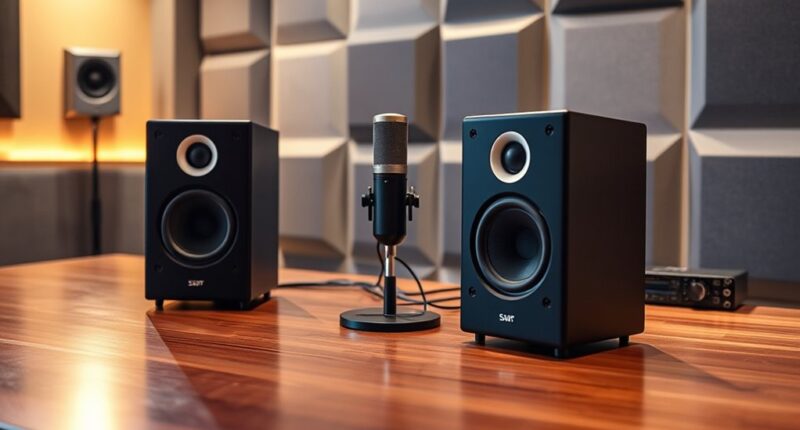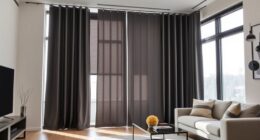If you’re looking for the 15 best studio monitor speakers for perfect sound in 2025, I’ve got you covered. I focused on models with high clarity, balanced sound, and versatile connectivity, like the PreSonus Eris series, Yamaha HS5, KRK RP5G5, and Mackie CR4. These monitors suit both professional studios and home setups, offering durability and great performance. Keep exploring and you’ll discover more options to help perfect your sound setup.
Key Takeaways
- Prioritize monitors with high clarity, flat frequency response, and balanced sound for accurate studio monitoring.
- Consider size, build quality, and space-saving design for optimal placement in small or desktop setups.
- Ensure versatile connectivity options like balanced TRS, RCA, and Bluetooth for seamless device compatibility.
- Look for models with sufficient power output and low distortion for professional-grade performance.
- Assess additional features such as adjustable controls, mounting options, and durability for long-term reliability.
PreSonus Eris 3.5 Studio Monitors, Pair
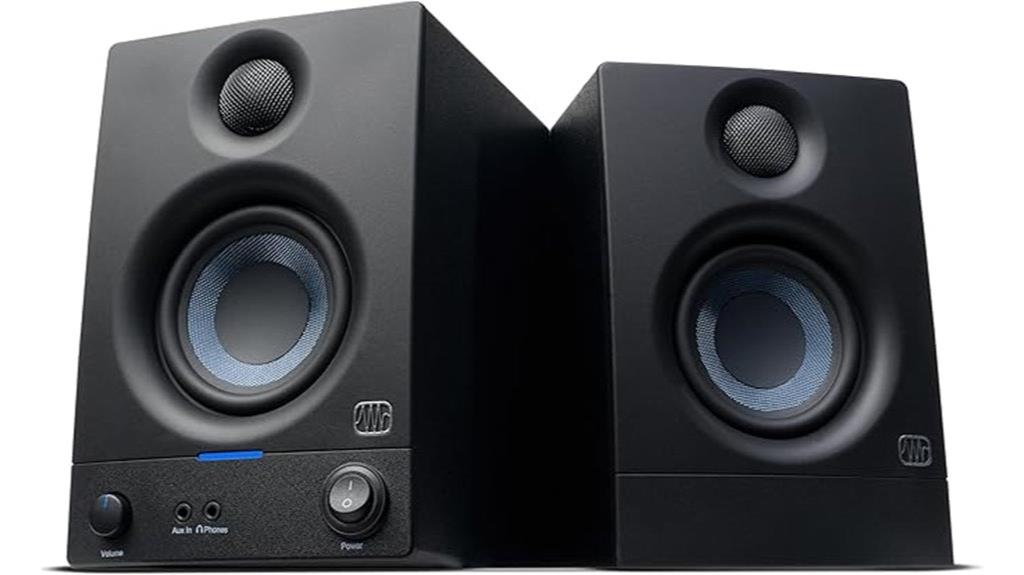
If you’re looking for compact studio monitors that deliver professional-quality sound, the PreSonus Eris 3.5 pair is an excellent choice. These monitors produce accurate, studio-grade audio with woven-composite woofers that deliver tight bass and cleaner sound overall. The 1-inch silk-dome tweeters ensure natural high-frequency response and excellent stereo imaging from almost any angle. With 50 watts of Class AB dual amplification, they provide powerful volume without losing clarity or tonal balance. Their compact design and wide listening sweet spot make them perfect for desktop use, whether you’re mixing music, enjoying hi-fi, or working on multimedia projects.
Best For: individuals seeking compact, high-quality studio monitors for music production, multimedia use, or hi-fi listening on a desktop setup.
Pros:
- Accurate, studio-grade sound with tight bass and clear high frequencies
- Wide listening sweet spot for consistent sound quality from various angles
- Versatile connectivity options including balanced TRS, RCA, and front-panel aux input
Cons:
- Limited low-frequency response due to small size, not suitable for deep bass needs
- May require additional acoustic treatment for optimal performance in larger rooms
- Power output may be insufficient for very large or loud environments
YAMAHA Hs5 Powered Studio Monitor, Pair

The Yamaha HS5 Powered Studio Monitor Pair is an excellent choice for audio professionals and serious enthusiasts who need accurate, transparent sound for critical listening and mixing. These bi-amped monitors feature a 5-inch cone woofer and a 1-inch dome tweeter, delivering a frequency response from 54 Hz to 30 kHz. With 45W for lows and 25W for highs, they provide clear, detailed audio without coloration. Versatile input options include XLR and TRS jacks, making connection easy. Designed for sonic purity, the HS5s emphasize true sound reproduction, helping you make precise adjustments and achieve professional results.
Best For: audio professionals and serious enthusiasts seeking accurate, transparent sound for critical listening and mixing.
Pros:
- Delivers clear, detailed audio with a natural sound profile
- Versatile input options including XLR and TRS for easy connectivity
- Powerful bi-amp system with 70W total output for high-quality performance
Cons:
- May be overkill for casual or beginner users
- Physical size and weight could be cumbersome for limited space setups
- Lacks built-in advanced features like room correction or Bluetooth connectivity
KRK RP5G5 ROKIT 5 Generation Five 5 Powered Studio Monitor Pair

For audio engineers and producers seeking precise and reliable sound reproduction, the KRK RP5G5 ROKIT 5 Generation Five powered studio monitors stand out with their custom-designed Class D amplifiers. These amps improve audio integrity and keep operating temperatures low, ensuring consistent performance. The new 1” silk dome tweeter enhances high-frequency clarity and phase accuracy, making details more audible. The low diffraction baffle design minimizes distortion and improves stereo imaging. Additionally, acoustic foam wedge isolation pads reduce resonance and support ideal placement. With XLR and 1/4” TRS inputs, these monitors offer broad compatibility, making them a versatile choice for professional and home studios alike.
Best For: audio engineers and music producers seeking precise, reliable, and high-quality studio monitoring.
Pros:
- Custom-designed Class D amplifiers enhance audio clarity and reduce heat, ensuring consistent performance
- 1” silk dome tweeter provides superior high-frequency response and phase accuracy
- Low diffraction baffle design minimizes distortion and improves stereo imaging
Cons:
- May be more expensive compared to entry-level monitors
- Requires proper acoustic treatment and placement for optimal performance
- Limited to professional or semi-professional studio environments due to high fidelity features
PreSonus Eris 4.5BT Bluetooth Studio Monitors

PreSonus Eris 4.5BT Bluetooth Studio Monitors are an excellent choice for creatives and hobbyists who need versatile, high-quality sound in a compact form. These monitors feature 4.5-inch woven-composite drivers that deliver punchy, accurate bass and smooth highs through 1-inch silk-dome transducers. With 25 watts of Class-AB power per speaker, they provide ample volume without sacrificing clarity. Their connectivity options are impressive, including Bluetooth 5.0, balanced ¼-inch TRS, RCA, and a front aux input, making them perfect for multimedia, gaming, or music production. Plus, their room tuning controls help optimize sound for any environment.
Best For: creators, hobbyists, or casual users seeking versatile, high-quality audio in a compact form suitable for multimedia, gaming, and music production.
Pros:
- Versatile connectivity including Bluetooth 5.0, TRS, RCA, and aux inputs for flexible device pairing.
- Compact size with powerful low-end response thanks to 4.5-inch woven-composite drivers.
- Room tuning controls allow precise adjustment for optimal sound in various environments.
Cons:
- Limited to 25 watts per speaker, which may be insufficient for larger or more demanding spaces.
- Absence of physical volume control knobs on the front panel could require additional setup for volume adjustments.
- Optional subwoofer purchase needed for extended low-end performance in critical listening scenarios.
PreSonus Eris 3.5 Studio Monitors (White)

If you’re setting up a compact, high-quality studio space, the PreSonus Eris 3.5 Studio Monitors in white are an excellent choice because they deliver accurate sound in a small form factor. These near-field speakers are perfect for bedroom studios, multimedia, and turntable setups, offering clear, balanced audio with a strong low end and refined highs. Equipped with 3.5-inch woven-composite woofers and 1-inch silk-dome tweeters, they provide tight bass and wide stereo imaging. With multiple connectivity options—including TRS, RCA, and front aux inputs—and adjustable high- and low-frequency controls, they’re versatile and customizable for various environments.
Best For: musicians, audio producers, and multimedia enthusiasts seeking compact, studio-quality sound for home or portable setups.
Pros:
- Compact size with a sleek, elegant design suitable for desktop or bookshelf placement
- Multiple input options (TRS, RCA, aux) for versatile connectivity
- Rich low end and refined highs with adjustable tuning controls for customized sound
Cons:
- Limited to 3.5-inch drivers, which may not satisfy those needing deep bass for large-scale mixing
- No built-in Bluetooth or wireless connectivity (unless paired with optional subwoofer)
- Power output is sufficient for small rooms but may not fill larger spaces with sound
Yamaha HS3 Powered Studio Monitor in Black, Pair (HS3 B)

The Yamaha HS3 Powered Studio Monitor in Black is an excellent choice for musicians, producers, and content creators who need accurate, transparent sound in a compact and affordable package. These monitors come as a pair and feature a sturdy wood enclosure with a 3.5-inch woofer and 0.75-inch dome tweeter, delivering a frequency response of 70 Hz to 22 kHz. They provide over 26 W of clean power and include multiple input options like XLR/TRS, RCA, and stereo mini-jacks. Ideal for small studios, they offer a wide stereo image and detailed sound, though you might want a subwoofer for richer bass. Their durable build and precise sound make them a reliable choice.
Best For: musicians, producers, and content creators seeking accurate, transparent sound in a compact, affordable studio monitor setup.
Pros:
- Excellent sound clarity with a flat, detailed frequency response
- Compact and durable wood enclosure suitable for small studio spaces
- Multiple input options (XLR/TRS, RCA, stereo mini) for versatile connectivity
Cons:
- Limited bass response may require a subwoofer for full-range sound
- Not water-resistant or Bluetooth-enabled, limiting certain uses
- Occasional issues like one speaker cutting out or needing resets
Edifier MR4 Powered Studio Monitor Speakers (Pair)

Designed for both music enthusiasts and creative professionals, the Edifier MR4 powered studio monitor speakers deliver high-quality sound in a compact package. Their white MDF wooden structure minimizes resonance, ensuring true, accurate audio reproduction. Equipped with a 4-inch composite woofer and a 1-inch silk dome tweeter, they produce clear highs, detailed mids, and punchy bass—adjustable via rear knobs. Connectivity options include RCA, TRS, AUX, and front headphone jack, making setup versatile. While lacking wireless features, they excel as desktop monitors, offering a wide soundstage and smooth sound profile. Overall, the MR4 provides an excellent balance of affordability, solid build, and studio-quality sound for both casual listening and creative work.
Best For: audiophiles, music creators, and casual users seeking accurate, high-quality desktop speakers at an affordable price.
Pros:
- Compact and stylish design with solid MDF wood structure for reduced resonance
- Versatile wired connectivity options including RCA, TRS, AUX, and headphone jack
- Excellent sound quality with clear highs, detailed mids, and punchy, adjustable bass
Cons:
- Lack of wireless features like Bluetooth limits connectivity options
- Non-smooth volume knob may affect precise adjustments
- Absence of water resistance or waterproofing, making them unsuitable for outdoor use
Mackie CR3.5 Creative Reference Powered Studio Monitors

For anyone seeking versatile studio monitors that deliver professional-quality sound without breaking the bank, the Mackie CR3.5 Creative Reference Powered Studio Monitors are an excellent choice. They offer a balanced mix of clarity and bass response, thanks to their silk dome tweeter and 3.5-inch woven woofer. I appreciate their flexible connectivity options, including TRS, RCA, and a headphone output, making them compatible with various devices. The adjustable tone control lets me tailor sound for different activities, whether gaming or mixing. Plus, their switchable placement mode ensures ideal sound whether on a desk or bookshelf. Overall, they combine affordability with impressive performance.
Best For: anyone seeking versatile, studio-quality monitors for music production, gaming, casual listening, or parties on a budget.
Pros:
- Clear, articulate sound with balanced bass response due to silk dome tweeter and woven woofer
- Flexible connectivity including TRS, RCA, and headphone output for compatibility with various devices
- Adjustable tone control and switchable placement mode for customized sound and optimal placement
Cons:
- Requires an external subwoofer (CR8SBT) for enhanced bass performance
- Limited size may not suit large or multi-room setups
- May need additional acoustic treatment for optimal sound in untreated spaces
Edifier R1280T Powered Bookshelf Speakers

If you’re looking for versatile studio monitor speakers that deliver professional-quality sound without breaking the bank, the Edifier R1280T powered bookshelf speakers are an excellent choice. With 42 Watts RMS power and a sleek wood finish, they combine style and durability. The 4-inch woofer and silk dome tweeter produce rich, clear, and balanced audio across all frequencies, perfect for music, movies, or gaming. Multiple input options, including RCA and AUX, make setup easy, while side panel controls and a remote provide convenient tuning. Rated 4.6 stars from thousands of reviews, these speakers offer natural sound, solid build, and great value for any multimedia setup.
Best For: users seeking affordable, high-quality studio monitor speakers suitable for music, movies, gaming, and home multimedia setups.
Pros:
- Delivers rich, clear, and balanced sound across all frequencies
- Multiple input options including RCA and AUX for versatile connectivity
- Convenient side panel controls and remote for easy tuning and adjustments
Cons:
- Lacks a dedicated subwoofer output for additional bass enhancement
- Remote control size might be inconvenient for some users
- Primarily designed for wired connection, with Bluetooth being secondary and limited
Ortizan C7 Stereo Monitors for Music Production (Pair, White)

The Ortizan C7 Stereo Monitors excel at delivering high-fidelity sound with their precise 3.5-inch carbon fiber mid-bass driver and silk dome tweeter, making them ideal for musicians and audio professionals who demand accurate monitoring. They offer versatile connectivity, including RCA, 6.35mm TRS, and 3.5mm AUX inputs, plus Bluetooth 5.3 for wireless pairing. The built-in 24-bit DAC guarantees clear digital audio, while professional tuning provides a flat frequency response for honest sound reproduction. With a sleek white design and front headphone jack, these active monitors support various setups, making them perfect for studio work, content creation, or casual listening.
Best For: musicians, audio professionals, and content creators seeking accurate, high-fidelity sound monitoring for studio work, mixing, and casual listening.
Pros:
- Offers versatile connectivity options including RCA, 6.35mm TRS, AUX, and Bluetooth 5.3 for seamless pairing
- Equipped with high-quality drivers and a professional tuning for flat, honest sound reproduction
- Features a front headphone jack for easy monitoring and quick switching between speakers and headphones
Cons:
- May be too compact for larger audio setups requiring higher output volume
- Limited to 3.5-inch drivers, which might not deliver deep bass for some users
- Designed primarily for desktop use, less suitable for large-scale or outdoor environments
ADAM Audio D3V Active Desktop Monitors (Pair, Black)

Designed specifically for desktop use, the ADAM Audio D3V Active Desktop Monitors deliver precise, high-quality sound that’s ideal for songwriters, producers, and music enthusiasts working in small spaces. Their stylish black finish, angled stands, and flexible mounting options make placement easy. Equipped with 3.5” aluminum woofers and dual passive radiators, they produce deep bass down to 45 Hz and clear midrange. The 1.5” D-ART ribbon tweeter ensures detailed high frequencies without fatigue. With USB-C connectivity, balanced inputs, DSP-based room adjustments, and user-friendly controls, these monitors combine professional sound with convenience, making them a versatile choice for desktop studio setups.
Best For: songwriters, producers, and music enthusiasts seeking high-fidelity desktop monitors with versatile connectivity and precise sound reproduction.
Pros:
- High-quality sound with deep bass down to 45 Hz and clear high frequencies from the D-ART ribbon tweeter
- Flexible mounting options including detachable stands and threaded holes for microphone stand attachment
- USB-C connectivity and DSP-based room adjustment features for easy integration and optimized sound in small spaces
Cons:
- Relatively small 3.5” woofers may not deliver full-range bass for larger studio environments
- Limited to desktop use, not suitable for large or professional studio setups requiring larger monitors
- Slightly higher price point compared to basic desktop speakers
JBL 305PMkII 5-Inch Studio Monitor Speaker

For musicians, producers, and audio enthusiasts seeking accurate sound reproduction in a compact size, the JBL 305P MkII 5-Inch Studio Monitor Speaker stands out as an excellent choice. It features next-generation JBL transducers, a sleek modern design, and a broad sweet spot for precise off-axis listening. Equipped with dual Class-D amplifiers delivering 82 watts, it offers deep bass, high clarity, and impressive dynamic range. The monitor covers a frequency range of 43Hz to 24kHz and includes adjustable HF trim and Boundary EQ for room optimization. Its durable MDF enclosure, mounting options, and 5-year warranty make it a reliable, versatile choice for professional and home studios.
Best For: musicians, producers, and audio enthusiasts seeking accurate, high-quality sound in a compact, versatile studio monitor for professional or home use.
Pros:
- Excellent clarity and detailed sound reproduction across the frequency range
- Broad sweet spot for precise off-axis listening, ideal for mixing and mastering
- Durable MDF enclosure with mounting options and a 5-year warranty for long-term reliability
Cons:
- Lacks built-in EQ adjustments, limiting room-specific tuning options
- Slightly larger footprint may require dedicated space on desks or stands
- Some users find the cabinet size and design less optimal for certain small or portable setups
Mackie CR4.5BT Studio Monitors with Bluetooth
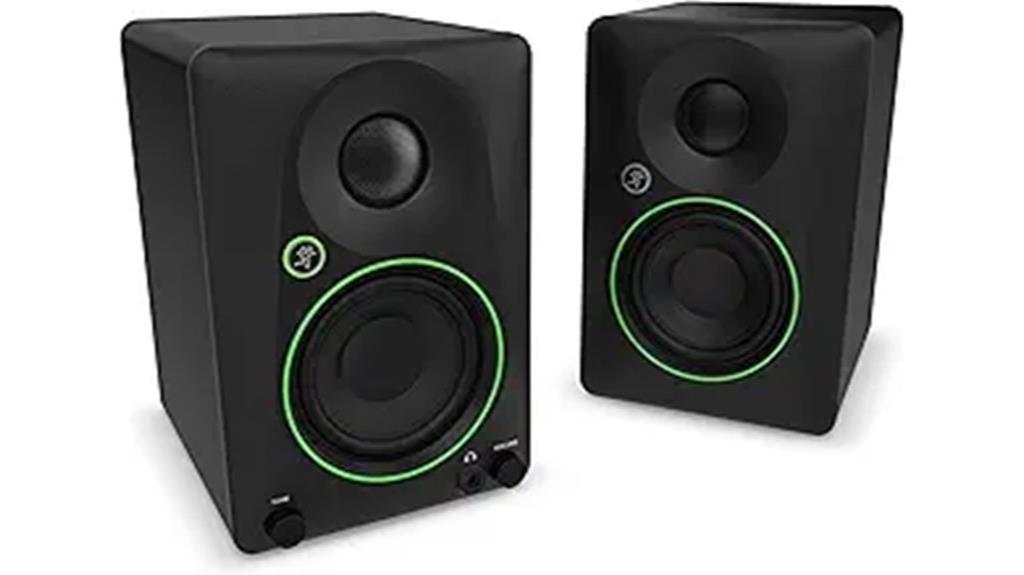
If you’re looking for versatile studio monitors that seamlessly blend professional sound quality with everyday convenience, the Mackie CR4.5BT stands out. These 4.5-inch powered monitors deliver clear, articulate audio with a balanced bass thanks to their woven woofer and silk dome tweeter. The built-in Bluetooth allows wireless streaming from your devices, while the tone control knob and location switch help optimize sound for different setups—desktop or bookshelf. Compact and easy to connect via TRS, RCA, or 3.5mm inputs, they suit music production, gaming, or casual listening. With positive reviews and a solid feature set, the CR4.5BT offers excellent value for versatile audio needs.
Best For: users seeking versatile, high-quality studio monitors suitable for music production, casual listening, gaming, and multimedia setups with wireless streaming capabilities.
Pros:
- Wireless Bluetooth connectivity for convenient device pairing and streaming
- Adjustable tone control and location switch for optimal sound tailoring to different environments
- Compact design with multiple input options (TRS, RCA, 3.5mm) for flexible setup
Cons:
- Not waterproof, limiting outdoor or damp environment use
- Limited to a 10-meter Bluetooth range, which may be restrictive for larger spaces
- Slightly heavier and larger than basic desktop speakers, requiring more space
OHAYO 60W Computer Speakers for Music and Gaming
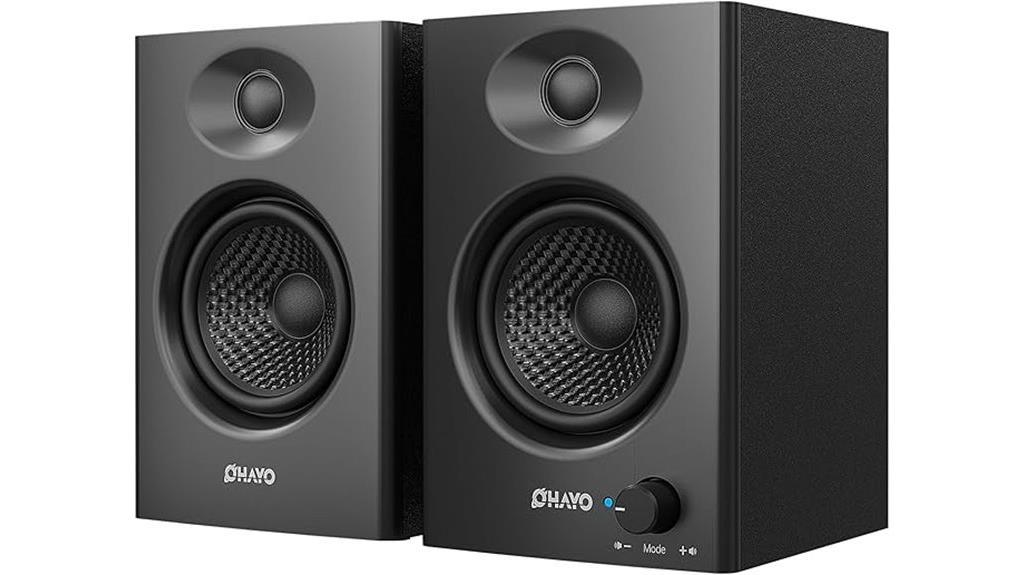
The OHAYO 60W Computer Speakers stand out as an excellent choice for gamers and music enthusiasts who want powerful, distortion-free sound without sacrificing space. These compact, stylish speakers deliver 30W per channel, filling up to 50 square meters with rich, clear audio. The combination of a carbon fiber silk dome tweeter and full-range driver ensures crisp highs and deep mid-bass, enhanced by a rear bass port. With Bluetooth 5.3, RCA, AUX, and USB inputs, they’re highly versatile. Easy front volume control and a durable MDF enclosure make setup simple, perfect for home offices or gaming stations seeking high-quality sound in a sleek package.
Best For: gamers and music lovers seeking powerful, clear sound in a compact, space-saving design suitable for home offices or gaming setups.
Pros:
- Delivers 30W per channel with distortion-free sound filling up to 50 square meters
- Versatile connectivity options including Bluetooth 5.3, RCA, AUX, and USB
- Stylish, modern design with durable MDF enclosure and easy front volume control
Cons:
- Limited to a single 2.0 stereo setup without additional surround sound features
- No waterproofing, which may be a concern in humid or spill-prone environments
- Slightly heavier weight (5.37 pounds) for portable use compared to smaller, lighter speakers
M-AUDIO BX3 Studio Monitors (Pair, 3.5″, 120W)

These M-AUDIO BX3 studio monitors are an excellent choice for content creators who need versatile, professional-quality sound on a budget. With 120 watts of power, they deliver clear, balanced audio perfect for gaming, podcasting, streaming, DJing, or music production. The 3.5-inch Kevlar woofers and silk dome tweeters produce deep, rich sound with precise imaging, enhanced by a computer-optimized waveguide. Built with an MDF cabinet and bass reflex design, they offer extended bass and immersive sound. Flexible connectivity options, including RCA, 1/4”, and 1/8” inputs, make setup easy. Plus, they come with software and cables to get started right away.
Best For: content creators, gamers, podcasters, streamers, DJs, and music producers seeking versatile, professional-quality sound on a budget.
Pros:
- Powerful 120W output delivers clear, balanced audio suitable for various applications
- Compact 3.5″ Kevlar woofers and silk dome tweeters produce deep, rich sound with precise imaging
- Flexible connectivity options (RCA, 1/4”, 1/8”) and included software make setup and integration easy
Cons:
- Might be less suitable for large or acoustically treated spaces due to their size and power limitations
- Some users may prefer larger monitors for more extensive studio setups
- Limited to 3.5″ drivers, which may not provide as deep bass as larger monitors
Factors to Consider When Choosing Studio Monitor Speakers

When selecting studio monitor speakers, I focus on sound accuracy and clarity to guarantee my mixes translate well. I also consider the frequency response range and connectivity options to match my setup and production needs. Finally, size, placement flexibility, and power are key factors that influence how well the monitors fit into my workspace and workflow.
Sound Accuracy and Clarity
Choosing studio monitor speakers with excellent sound accuracy and clarity is vital because it guarantees your mixes reflect the true nature of your recordings. Accurate monitors deliver a flat frequency response, so you’re hearing sound without coloration or emphasis on specific ranges. Clarity comes from high-quality drivers like silk-dome tweeters and woven-composite woofers, which reveal detailed high and low frequencies. A precise transient response ensures sudden sound changes are reproduced faithfully, essential for editing and mixing. Proper acoustic design minimizes distortion and maintains phase accuracy, enhancing overall clarity and consistency across listening angles. Additionally, balanced inputs and a high signal-to-noise ratio prevent unwanted noise, preserving the integrity of your audio. These factors ensure your mixes translate well across different systems and environments.
Frequency Response Range
Have you ever wondered how well a studio monitor can reproduce the full range of sounds in your mix? The frequency response range is key—it’s what determines how accurately your monitor can reproduce different audio frequencies, measured in Hertz (Hz). A wider range, typically from around 40 Hz to over 20 kHz, ensures that both deep bass and sparkling high frequencies are delivered clearly. This is essential for mixing and mastering, as it helps you hear every detail accurately. If a monitor’s frequency response is limited or uneven, certain sounds might be exaggerated or lost, impacting your overall audio fidelity. When choosing monitors, look for models with a broad and flat frequency response to achieve the most balanced and true-to-life sound reproduction.
Connectivity Options
Selecting the right studio monitor involves guaranteeing it has the appropriate connectivity options to match your existing equipment. I look for monitors with input types like XLR, TRS, RCA, or AUX, depending on my setup. Balanced connections such as XLR and TRS are ideal because they reduce noise and interference, giving me cleaner audio. Some monitors offer multiple input options, which makes switching between my computer, mixer, or audio interface seamless. Wireless features like Bluetooth can add convenience, but I keep in mind they might compromise signal stability. Before purchasing, I double-check that the input connectors are compatible with my gear to avoid setup hassles and assure excellent sound quality. Connecting everything smoothly is essential for accurate monitoring.
Size and Placement Flexibility
When fitting studio monitor speakers into your space, size and placement flexibility are essential for achieving accurate sound and comfortable setup. Choosing a monitor size that matches your room ensures you get precise audio without overpowering small spaces. Smaller monitors, like those with 3.5 to 4-inch drivers, are perfect for desktop setups, while larger speakers with 5 inches or more suit bigger rooms. Adjustable stands or wall-mount options make placement easier, helping you position monitors for ideal stereo imaging. Proper placement involves setting monitors at ear level and keeping them about 3 to 4 feet apart. Look for monitors with versatile mounting options and adjustable acoustic controls, so you can adapt your setup to different room sizes and acoustics for the best sound quality.
Power and Amplification
The power and amplification of studio monitor speakers play a essential role in delivering clear, distortion-free sound at the desired volume levels. Power, measured in watts, typically ranges from 25W to over 120W per speaker, impacting maximum volume and headroom. Higher wattage allows for louder playback without distortion, which is paramount in large rooms or when working at high volumes. The type of amplification, such as Class AB or Class D, affects efficiency, heat output, and sound clarity. Bi-amped monitors, with separate amps for high and low frequencies, offer better control and transparency across the spectrum. Matching the monitor’s power to your room size and listening needs helps prevent distortion or clipping, ensuring ideal performance and accurate sound reproduction.
Frequently Asked Questions
How Do Studio Monitors Differ From Regular Speakers?
Studio monitors differ from regular speakers because they’re designed for accuracy, not loudness or bass boost. I find they produce a flat, uncolored sound, so I can hear every detail in my recordings without distortion. Regular speakers often emphasize bass or treble, which can mislead my mixing. With studio monitors, I get a clear, true representation of my sound, helping me make better mixing and mastering decisions.
What Is the Ideal Room Size for Specific Monitors?
The ideal room size for studio monitors varies, but I’ve found a space around 150 to 300 square feet works best. Studies show that room dimensions influence sound accuracy, with larger rooms reducing reflections and echo. I recommend keeping the room well-treated acoustically, avoiding too much clutter, and positioning monitors properly. This setup guarantees you get accurate, balanced sound, helping you create mixes that translate well everywhere.
How Important Is Frequency Response in Monitor Selection?
Frequency response is vital when choosing studio monitors because it determines how accurately they reproduce sound across different pitches. I pay close attention to this to ensure my mixes translate well across various systems. A flat, wide frequency response means I hear true audio without coloration or bias, helping me make precise adjustments. If the response isn’t accurate, my mixes could sound off elsewhere, so I always prioritize monitors with reliable frequency ranges.
Can Studio Monitors Be Used for Casual Listening?
Absolutely, you can use studio monitors for casual listening. I do it all the time because they deliver accurate sound, which makes music sound clearer and more detailed. However, keep in mind that monitors are designed for precision, so they might lack the bass or warmth you find in regular speakers meant for entertainment. Still, if you appreciate true-to-life sound, they’re a great choice for everyday listening too.
What Maintenance Tips Ensure Long-Term Monitor Performance?
To guarantee long-term monitor performance, I regularly keep my speakers clean, check the cables for wear, and keep them in a stable environment. I avoid exposing them to extreme temperatures or humidity, and I turn them off when not in use. I also monitor their sound quality, addressing any distortions promptly. By maintaining cleanliness, stability, and attentive care, I keep my monitors sounding fresh and performing reliably over time.
Conclusion
So, I get it—choosing the right studio monitor can feel overwhelming. But remember, the perfect pair isn’t about the biggest or most expensive; it’s about matching your space and style. Don’t let fear of making the wrong choice hold you back. Trust your ears, test a few options, and you’ll find the ideal monitors to elevate your sound. Your perfect mix is closer than you think—just take that first step.
